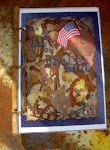I understand at the genetic level the need to revolt. My genetic make-up comes from a people who are good at it.
Still, it is disheartening to read the word, as written by modern-day Americans and friends, in response to the perceived – and often very real – dismissal and disdain shown by our elected officials for those who elected them. The response is almost universal now amongst regular folks everywhere … “remove these pretenders from office before they can do any more harm.”
I cannot disagree with the reasoning, but I do disagree with the common reasoned solution.
The question really is: what you believe? And it really is that simple. Consider history.
From 1929 to 1933, the United States was in the throes of the Great Depression. Simultaneously, massive errors in farming practices and natural weather patterns produced the Dust Bowl – and brought devastation to the western U.S. This all occurred during a time when just a decade previous, the “Spanish” Influenza killed 50 million people worldwide. Within that same timeframe, the end of the “Great War” saw approximately 38 million dead. By 1929, despite a bull market leading up to the depression, the crash still occurred, as well as everything that went with it, there was little reason to hope. In fact, the median for education amongst adults living during the 30s was 8.1 years of school. Only about five percent of U.S. youth had ever seen the inside of a college. Less than 40 percent had completed High School.
Life was dark, much seemed hopeless and beyond the control of man. In many places, people were resorting to anything, for just a little bit of hope. Organized crime flourished – violence, strikes and corruption increased, as did racially motivated killings.
What was needed was not greater control and more grasping for power, but simply, a strength of belief.
January 7, 1929, newspapers carried a new comic strip. Comic strips were very popular due to the literacy level of the average citizen. In this case, the strip was something John Flint Dille had been planning for some time, but which finally came to life with the illustrations of Frank Paul. The story had already begun in 1928 in the August edition of Amazing Stories, as written by Phillip Nowlan., including in the title, the word “Armageddon.”
The comic strip Dille had wanted to produce for some time was all about a single purpose: Produce hope … give people something to believe in. The prologue described a man who had just left the air service after a World War, and through an accident in his new civilian job, became accidentally entombed in a mine – only to awake in the year 2429. This simple prologue was of course, the beginning of a name, which would become known around the world … “Buck Rogers.”
Consider this: What kind of hope do you have for the future? How do you think the next year will develop? What do you think will happen to the United States if we have to suffer through another year of a chief executive’s vacationing, golfing, and systematic disassembly of the economy? What results can we expect with further regulation, further control of people’s day-to-day lives?
If we call the America we currently live in, “Orwellian,” then what hope do we have of escape and rebirth? Remember, this … our society is nowhere near as troubled as that of the generation of the Great Depression. We just need something to catch a glimpse beyond the horizon. We need something to believe in.
The miracles depicted in Buck Rogers include rockets, flying machines, television, two-way video communication, cell phones, digital displays – and many other current conveniences. The truth of the power of the convictions which birthed these things was not found in the adult population of that time – but rather the children. By 1929, the comic was everywhere, featuring not just the resourceful Buck Rogers, but the brilliant scientist, Dr. Huer and the courageous and beautiful companion, Wilma Deering.
Children loved it. It became the longest running comic strip in American history – and that’s the real answer to our country’s current predicament – and the way to escape the feeling of despair, which is fueling anxiety across the nation.
We need the children to get all of us there.
We need the children to get all of us there.
Any adult today is fairly irrelevant if they are not doing their part to inspire and encourage the children and teens around them. Because, like the time of the Great Depression, our days of darkness will not be numbered in a year or two or three – and it will not be a civil project or free money, or war, or any other such scheme which will give us new life and new purpose. As adults, we simply do not have the time necessary to create the beautiful thing which is even now, just out of sight and out of reach. But even if we do, the future belongs to someone else.
It will be the children, who having been stoked on the hopes and possibilities and beliefs of our time, will create the next great world of wonder and growth and development. Their capabilities and talents and truth will create even greater inspiration, if we only help them to get there.
It is this simple: as long as we can find the strength to believe in those children and their imagination, we may someday live in a new kind of world. I see that place sometimes in my rare good sleeps, as a crystalline world in which the best, noblest parts of humankind meet a newly imagined frontier of science, religion, art, renewal, rebirth and most of all …
…. dreams.
We can get there. But only if you believe.
We can get there. But only if you believe.


















No comments:
Post a Comment